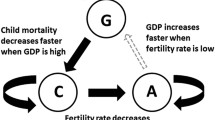Abstract
The widely-observed finding in the literature showing little or no relationship between population growth (and dependency) and saving requires modification based on panel and cross-section estimation of aggregate country data. While such a relationship is still weak in the hybrid Leff-type model, it is now found consistently over time and by stage of development in the Mason variable-growth life-cycle framework, where changes in demographic factors account for a notable part of saving.
Similar content being viewed by others
References
Barro RJ, Lee J-W (1993) Losers and winners in economic growth. Working Paper No. 4341. National Bureau of Economic Research, Cambridge, MA
Brander JA, Dowrick S (1994) The role of fertility and population in economic growth: empirical results from aggregate cross-national data.Journal of Population Economics 7:1–25
Coale AJ, Hoover EM (1958)Population growth and economic development in low-income countries. Princeton University Press, Princeton, NJ
Collins SM (1991) Saving behavior in ten developing countries. In: Bernheim BD, Shoven JB (eds)National saving and economic performance. University of Chicago Press, Chicago
Davidson R, MacKinnon JG (1993) Estimation and inference in econometrics. Oxford University Press, New York
Fagerberg J (1994) Technology and international differences in growth rates.Journal of Economic Literature 32:1147–1175
Feldstein M, Baccheta P (1991) National saving and international investment. In: Bernheim BD, Shoven JB (eds)National saving and economic performance. University of Chicago Press, Chicago
Fry MJ, Mason A (1982) The variable rate-of-growth effect in the life-cycle saving model.Economic Inquiry 20:426–442
Giovannini A (1983) The interest elasticity of savings in developing countries: the existing evidence.World Development 11:601–607
Hammer JS (1986) Children and savings in less developed countries.Journal of Development Economics 23:107–118
Higgins MD (1994) The demographic determinants of savings, investment and international capital flows. Ph. D. Dissertation, Harvard University. UMI Dissertation Services, Ann Arbor
Kelley AC (1988a) Economic consequences of population change in the third world.Journal of Economic Literature 27:1685–1728
Kelley AC (1988b) Population pressures, saving and investment in the third world: some puzzles.Economic Development and Cultural Change 36:449–464
Kelley AC (1996) The consequences of population growth on human resource development: the case of education. In: Ahlburg DA, Kelley AC, Mason KO (eds) The impact of population growth on well-being in developing countries. Springer-Verlag, Berlin Heidelberg New York
Kelley AC, Schmidt RM (1994) Population and economic growth: recent evidence. World Bank Discussion Papers 249. The World Bank, Washington, DC Lee RD (1983) Economic consequences of population size, structure and growth. IUSSP Newsletter 17:43-59
Leff NH (1969) Dependency rates and savings rates. American Economic Review 59:886–896
Mason A (1981) An extension of the life-cycle model and its application to population growth and aggregate saving. East West Population Institute Working Paper No. 4, Honolulu, January
Mason A (1987) National saving rates and population growth: a new model and new evidence. In: Johnson DA, Lee R (eds) Population growth and economic development: issues and evidence. University of Wisconsin Press, Madison
Modigliani F, Ando AK (1957) Tests of the life cycle hypothesis of saving: comments and suggestions.Bulletin of Oxford University Institute of Economics and Statistics 19:99–124
Modigliani F, Brumberg R (1954) Utility analysis and the consumption function: An interpretation of cross section data. In: Kurihara KK (ed)Post-Keynesian economics. Rutgers University Press, New Brunswick, NJ
Schultz TP (1987) School expenditures and enrollments, 1950-1980: the effects of income, prices and population growth. In: Johnson DA, Lee R (eds)Population growth and economic development- issues and evidence. University of Wisconsin Press, Madison
Simon JL, Pilarski AM (1979) The effect of population growth upon the quantity of education children receive.Review of Economics and Statistics 61:572–584
Summers R, Heston A (1995) Data update 5.6a, computer diskette based on The Penn World Table (Mark 5): an expanded set of international comparisons, 1950–1988
Taylor AM (1995) Domestic saving and international capital flows reconsidered. Working Paper No. 4892. National Bureau of Economic Research, Cambridge, MA
Taylor AM, Williamson JG (1994) Capital flows to the new world as an intergenerational transfer.Journal of Political Economy 104:348–371
UNESCO (various years)Statistical yearbook. United Nations Educational, Scientific and Cultural Organization, Paris
USAID, Office of Disaster Assistance (1989) Disaster history. Report by Labat-Anderson, Inc. 22201
World Bank (1994)World Data 1994: World Bank Indicators on CD-ROM
Author information
Authors and Affiliations
Rights and permissions
About this article
Cite this article
Kelley, A.C., Schmidt, R.M. Saving, dependency and development. J Popul Econ 9, 365–386 (1996). https://doi.org/10.1007/BF00573070
Received:
Accepted:
Issue Date:
DOI: https://doi.org/10.1007/BF00573070




